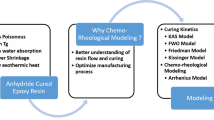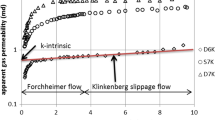Abstract
Models based on a mass-diffusion theory successfully represent the growth and collapse of gas bubbles in an epoxy resin. A quantitative evaluation of the steady-state diffusion equations requires values for the diffusion coefficient and the solubility of the mobile species within the resin precursor. These parameters are affected by changes in temperature and/or pressure, and they are generally not measured as part of a processing schedule. Models have been evaluated that predict the temperature dependence of the gas diffusion coefficient in the resin. A free volume approach describes the viscosity of the resin successfully at temperatures of up to 100 K above the glass-transition temperature. At higher temperatures, a thermal-energy-barrier approach is more appropriate. A direct correlation between the viscosity of the resin and the gas diffusion coefficient is proposed which is considered to be applicable to any gas/resin system where specific component interactions are negligible and the solute concentration is sufficiently low that it does not affect the free volume of the medium.
Similar content being viewed by others
References
J. R. WOOD, PhD thesis, University of Surrey, England (1992).
J. R. WOOD, and M. G., BADER, Proceedings of 8th International Conference on Composite Materials. Composites: Design, Manufacture and Application. (ICCM-8), Honolulu, edited by S. W. Tsai and G. S. Springer. (SAMPE, Covina, USA) paper no. 10-M, July (1991) 1–9.
H. EYRING,J. Chem. Phys. 4 (1936) 283.
S., GLASSTONE, “Textbook of physical chemistry” (MacMillan, London, 1948) p. 499.
T. G. FOX, and P. J. FLORY,J. Phys. Chem. 55 (1951) p. 221.
P. MEARES, “Polymers: structure and bulk properties”, (Van Nostrand, London, (1965) p. 237.
M. L. WILLIAMS, R. F. LANDEL and J. D. FERRYJ. Amer. Chem. Soc. 77 (1955) 3701.
J. M. G. COWIE, “Polymers: chemistry and physics of modern materials” (Intertext Books, Aylesbury, UK (1973) 201.
F. BUECHE,J. Chem. Phys. 20 (1952) 1959.
Shell Resins Epikote Technical Manual, E. P. 1. 1. 12, 3rd Edn (Shell, 1987).
H. BATZER and S. A. ZAHIR,J. Appl. Polym. Sci. 19 (1975) 585.
K. RAVINDRANATH, and K. S. GHANDI,ibid. 19 (1979) 1115.
P. J. FLORY,J. Amer. Chem. Soc. 62 (1940) 1057.
J. R. WOOD, and M. G. BADER, Proceedings of the 9th International Conference on Composite Materials Composites: Modelling and Processing Science. (ICCM-9), edited by A. Miraveta (Univ. of Zaragoza and Woodhead, Zaragoza, Spain) Vol. 3 Madrid, 12–16 July (1993) Section 5, p. 567.
J. FRENKEL, “Kinetic theory of liquids” (Oxford University Press, 1946) p. 206 and p. 194.
J. H. HILDEBRAND,J. Amer. Chem. Soc. 38 (1916) 1452.
J. R. WOOD, and M. G. BADER,J. Mater. Sci. 29 (1994) 844.
G. C. PIMENTAL, and A. L. McCLELLAN, “The hydrogen bond” (Freeman, San Francisco, 1960) p. 212.
W. D. KINGERY, H. K. BOWEN, and D. R. UHLMANN, “Introduction to ceramics”, (Wiley, New York, 1976) p. 704.
J. V. ALEMAN,J. Polym. Sci. 18 (Polymer Chemistry Edition), (1980) 2561.
F. W. BILLMEYER, “Textbook of polymer science” (Wiley, New York, 1962) p. 210.
A. K., DOOLITTLE,J. Appl. Phys. 22 (1951) 1471.
P. MEARES,J. Amer. Chem. Soc. 76 (1954) 3415.
W. W. BRANDT,J. Phys. Chem. 63 (1959) 1080.
F. BUECHEJ. Chem. Phys. 20 (1952) 1959.
A. PETERLIN,J. Macromolecular Sci. Phys. B 11 (1975) 57.
Author information
Authors and Affiliations
Rights and permissions
About this article
Cite this article
Wood, J.R., Bader, M.G. Modelling the behaviour of gas bubbles in an epoxy resin: Evaluating the input parameters for a diffusion model using a free-volume approach. J Mater Sci 30, 916–922 (1995). https://doi.org/10.1007/BF01178425
Received:
Accepted:
Issue Date:
DOI: https://doi.org/10.1007/BF01178425




